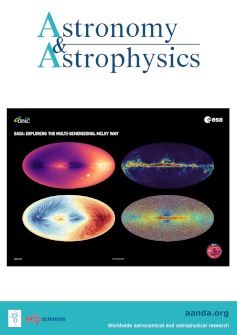Broad-band noises in GX 339-4 during the 2021 outburst observed with Insight-HXMT and NICER
IF 5.4
2区 物理与天体物理
Q1 ASTRONOMY & ASTROPHYSICS
引用次数: 0
Abstract
Rapid X-ray variability of GX 339−4 including the low-frequency quasi-periodic oscillations (LFQPOs) and broad-band noises were observed with the Hard X-ray Modulation Telescope (Insight-HXMT) and Neutron star Interior Composition Explorer (NICER) during the 2021 outburst. Here we present a systematic study of the evolution and energy dependence properties of such broad-band noises (BBNs). The outburst from February to March of 2021 can be divided into three stages: the low hard state (LHS), the hard intermediate state (HIMS), and soft intermediate state (SIMS). In the PDSs of the LHS and HIMS, the broad-band noises were well fitted with three Lorentzian components: a low-frequency component L1, a middle-frequency component L2, and a high-frequency component L3. The increasing trend of the characteristic frequencies for L1 and L2 and the relation between the QPO frequency and characteristic BBN frequency are reported. We find that the energies corresponding to the peaks and shapes of the rms spectra for three BBN components are different. The comparison among three BBN components indicates that energy-dominant bands of these BBN components are distinct. Our results can be explained with the truncated disc and hot flow model with a large variable disc and a small hot inner flow. A possible description of the accretion structure and its evolution from the LHS to the SIMS is proposed. Further research is still required to probe such an accretion structure in GX 339-4.Insight-HXMT和NICER观测到2021年爆发期间GX 339-4中的宽带噪声
利用硬x射线调制望远镜(Insight-HXMT)和中子星内部成分探测器(NICER)观测到GX 339−4在2021年爆发期间的快速x射线变化,包括低频准周期振荡(LFQPOs)和宽带噪声。本文系统地研究了这种宽带噪声的演化和能量依赖特性。2021年2 ~ 3月的爆发可分为低硬状态(LHS)、硬中间状态(HIMS)和软中间状态(SIMS)三个阶段。在LHS和HIMS的pds中,宽带噪声很好地拟合了三个洛伦兹分量:低频分量L1、中频分量L2和高频分量L3。报道了L1和L2特征频率的增加趋势以及QPO频率与BBN特征频率的关系。我们发现三种BBN组分的峰对应能量和均方根谱的形状是不同的。三个BBN分量的比较表明,这些BBN分量的能量优势带是不同的。我们的结果可以用一个大的可变圆盘和一个小的内部热流动的截断圆盘和热流模型来解释。提出了从LHS到SIMS的吸积结构及其演化的可能描述。要探测GX 339-4中的这种吸积结构,还需要进一步的研究。
本文章由计算机程序翻译,如有差异,请以英文原文为准。
求助全文
约1分钟内获得全文
求助全文
来源期刊

Astronomy & Astrophysics
地学天文-天文与天体物理
CiteScore
10.20
自引率
27.70%
发文量
2105
审稿时长
1-2 weeks
期刊介绍:
Astronomy & Astrophysics is an international Journal that publishes papers on all aspects of astronomy and astrophysics (theoretical, observational, and instrumental) independently of the techniques used to obtain the results.
 求助内容:
求助内容: 应助结果提醒方式:
应助结果提醒方式:


